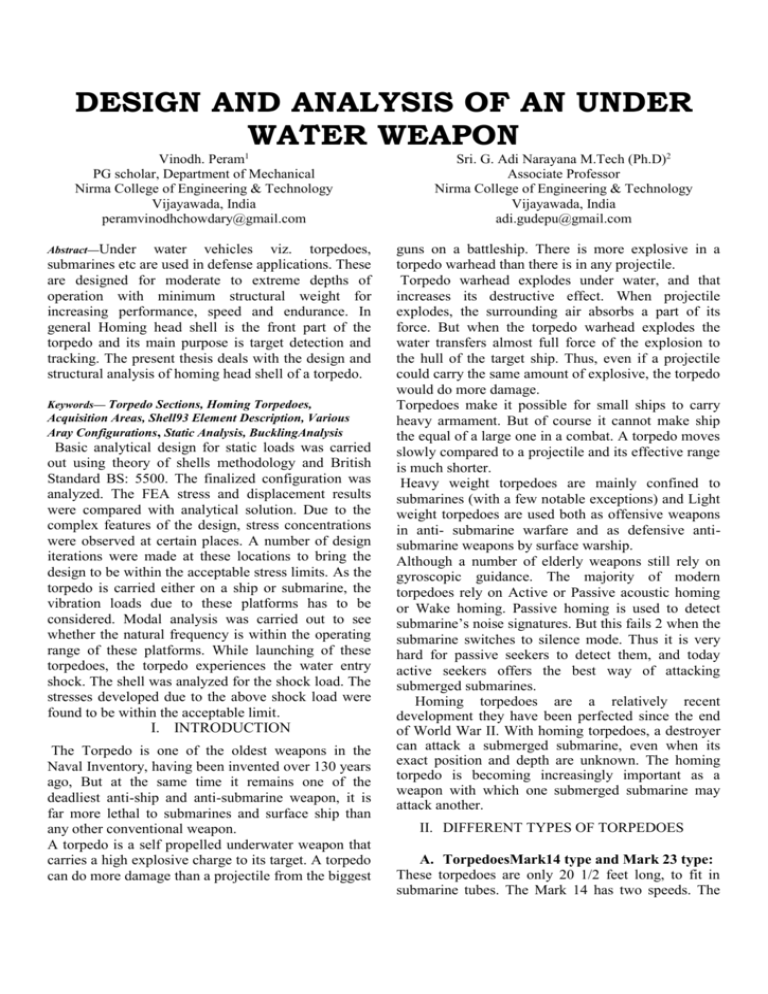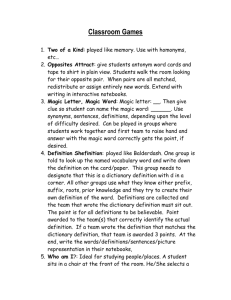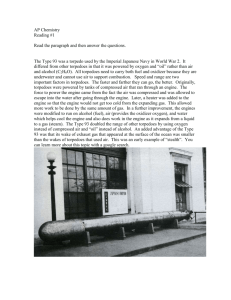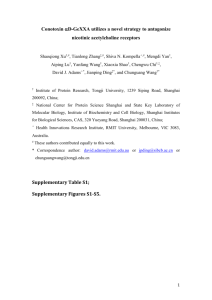Paper Title (use style: paper title)
advertisement

DESIGN AND ANALYSIS OF AN UNDER WATER WEAPON Vinodh. Peram1 PG scholar, Department of Mechanical Nirma College of Engineering & Technology Vijayawada, India peramvinodhchowdary@gmail.com Abstract—Under water vehicles viz. torpedoes, submarines etc are used in defense applications. These are designed for moderate to extreme depths of operation with minimum structural weight for increasing performance, speed and endurance. In general Homing head shell is the front part of the torpedo and its main purpose is target detection and tracking. The present thesis deals with the design and structural analysis of homing head shell of a torpedo. Keywords— Torpedo Sections, Homing Torpedoes, Acquisition Areas, Shell93 Element Description, Various Aray Configurations, Static Analysis, BucklingAnalysis Basic analytical design for static loads was carried out using theory of shells methodology and British Standard BS: 5500. The finalized configuration was analyzed. The FEA stress and displacement results were compared with analytical solution. Due to the complex features of the design, stress concentrations were observed at certain places. A number of design iterations were made at these locations to bring the design to be within the acceptable stress limits. As the torpedo is carried either on a ship or submarine, the vibration loads due to these platforms has to be considered. Modal analysis was carried out to see whether the natural frequency is within the operating range of these platforms. While launching of these torpedoes, the torpedo experiences the water entry shock. The shell was analyzed for the shock load. The stresses developed due to the above shock load were found to be within the acceptable limit. I. INTRODUCTION The Torpedo is one of the oldest weapons in the Naval Inventory, having been invented over 130 years ago, But at the same time it remains one of the deadliest anti-ship and anti-submarine weapon, it is far more lethal to submarines and surface ship than any other conventional weapon. A torpedo is a self propelled underwater weapon that carries a high explosive charge to its target. A torpedo can do more damage than a projectile from the biggest Sri. G. Adi Narayana M.Tech (Ph.D)2 Associate Professor Nirma College of Engineering & Technology Vijayawada, India adi.gudepu@gmail.com guns on a battleship. There is more explosive in a torpedo warhead than there is in any projectile. Torpedo warhead explodes under water, and that increases its destructive effect. When projectile explodes, the surrounding air absorbs a part of its force. But when the torpedo warhead explodes the water transfers almost full force of the explosion to the hull of the target ship. Thus, even if a projectile could carry the same amount of explosive, the torpedo would do more damage. Torpedoes make it possible for small ships to carry heavy armament. But of course it cannot make ship the equal of a large one in a combat. A torpedo moves slowly compared to a projectile and its effective range is much shorter. Heavy weight torpedoes are mainly confined to submarines (with a few notable exceptions) and Light weight torpedoes are used both as offensive weapons in anti- submarine warfare and as defensive antisubmarine weapons by surface warship. Although a number of elderly weapons still rely on gyroscopic guidance. The majority of modern torpedoes rely on Active or Passive acoustic homing or Wake homing. Passive homing is used to detect submarine’s noise signatures. But this fails 2 when the submarine switches to silence mode. Thus it is very hard for passive seekers to detect them, and today active seekers offers the best way of attacking submerged submarines. Homing torpedoes are a relatively recent development they have been perfected since the end of World War II. With homing torpedoes, a destroyer can attack a submerged submarine, even when its exact position and depth are unknown. The homing torpedo is becoming increasingly important as a weapon with which one submerged submarine may attack another. II. DIFFERENT TYPES OF TORPEDOES A. TorpedoesMark14 type and Mark 23 type: These torpedoes are only 20 1/2 feet long, to fit in submarine tubes. The Mark 14 has two speeds. The low-power setting will give a range of 9,000 yards at approximately 32 knots, and the high-power setting, a range of 4,500 yards at 46 knots. Its war head contains about 700 pounds of high explosive. There are no side-gear assemblies in the main engine of this torpedo. The two speed settings are obtained by changing the number of nozzle jets in use (two for low speed, five for high) and by altering the size of the restrictions in the air, fuel, and water delivery lines. The Mark 14 torpedo has a governor whose function is to stop the torpedo, if the starting lever is tripped accidentally, before the engine develops excessive speed, and thereby to safeguard personnel and to prevent serious damage to the torpedo. B. Torpedo Mark 18 type: The Mark 18 is an electrically propelled torpedo designed for use in submarines. It is single-speed, designed to run for 4,000 yards at an average speed of about 29 knots. The primary advantage of the Mark 18 is that it is wakeless. In place of an air-flask section this torpedo has a battery compartment, which contains a lead-acid storage battery, a hydrogen eliminator, and a ventilating system. The battery runs a 90-horsepower series electric motor (located in the afterbody) whose armature is connected by the main drive shaft and gearing to two counter-rotating propellers. Compressed air-required to close the starting switch, spin the gyro, and operate the depth and steering engines-is stored at 3,000 psi in three small flasks in the afterbody. The gyro is of “run-down” type. After the initial spin the air is shut off and the gyro is unlocked; the gyro wheel continues to spin of its own momentum. The war head contains about 600 pounds of high explosive. C. Homing torpedoes: The torpedoes described above are designed to take up the course set on their gyro mechanisms, and then run in a straight line. Homing torpedoes can also follow a gyro course. In addition, a homing torpedo can search for a target, and, when it finds one, chase it until it secures a hit. Some types can switch back and forth between gyro control, search pattern, and homing control, as appropriate. Several types of homing torpedoes are now in the Fleet, and others are in various stages of development. For security reasons, only a short and very general discussion can be given here. At present, homing torpedoes are acoustic (operated by sound). In general, they are of two types-active and passive. The active type sends out short pulses of sound, and “listens” for echoes from the target. When an echo is detected, the torpedo steers itself toward the source of the echo. The passive type merely listens for target sounds (such as propeller and machinery noises), then steers itself toward the source of the sounds. III. EXISTING SYSTEM A. Acquisition Areas : The primary task of torpedo sonar is to detect acoustically the target and thus compensate for the position errors of the torpedo relative to the target, which are inevitable and become greater with an increasing distance. If the acquisition area is too small, then the risk of passing the target without any target contact becomes high and the probability of success goes down. The various errors to be considered will become very large, due to the navigational errors of the firing submarines and due to flow in homogeneities. The homing head of the torpedo is required to be designed with the following requirements in view. Provision for maximum possible Transducer Elements Placement of Transmitting and Receiving SOBID elements Housing the Echo sounder at the bottom of the homing head Peripheral positioning of 4 Numbers proximity Fuse 17 Mounting arrangements for front-end electronics and Signal processing Unit. IV. PROPOSED METHOD VARIOUS CONFIGURATIONS Taking into consideration of all the requirements of the homing head, various configurations were tried out, without compromising on the functional aspects. Four configurations were worked out and they are as follows. Planar Array Conformal array Circular array A. Planar Array : This is the simplest configuration tried out. In this configuration the homing transducer elements are placed in a planner array. The planar array consists of 6 x 6 or 8 x 8 array. The transducer mounting plate in this configuration is a flat plate with 36 or 64 circular holes, through which the stress rod of the transducer elements will project into the interior. The SOBID elements are placed at the periphery of the array for object identification and transmission .Two SOBID elements for object receiving and the other two for transmission. The main disadvantage of this model is as the number of transducer elements are less the viewing area is less so an optimum search of the target is not possible. In order to overcome this look up area and the number of transducer elements are to be increased so that the torpedo can view through better area. V. RESULTS AND ANALYSIS OF AN UNDER WATER WEAPON A. Static Analysis : The following plot shows the vonmises stress values on the model. The maximum stress is 458.408Mpa, but this has no meaning as this is seen on a support region. Except the value at singularity the maximum stress is observed near the circumference of the homing transducer pocket opening and is equal to 152.803Mpa. The stress value is in the range of 160Mpa, which is in agreement with the theoretical value calculated. Element SHELL 93 Poison’s ratio 0.32 Young’s Modulus 71000 MPa Planar array Loads: An external pressure of 72 bar is applied on the outer shell Boundary conditions Ux=Uy=Uz=0 at Y=0 Axis of the shell - Y axis B. Conformal Array : In order to increase the viewing area the planner arrangement of the transducer elements in the above configuration have been modified to conformal arrangement. The conformal array consists of two arrays. The mounting plate for the transducer elements in this configuration is a box cut which has 96 circular holes. SOBID elements are placed. Acoustic proximity fuse are placed which determines the proximity of the torpedo with the target. The look up area compared to planar array has been increased but the hydrodynamic shape has been violated. static analysis of maximum vonmises stress is 458.408Mpa Conformal array C. Circular Array : Due to the arrangement of the transducers adapted to the head shape(conformal array ),the simultaneous reception of acoustic signals over the entire angular range of +/-90 degree and more with reference to the torpedo axis is assured with out any negative impact on the acquisition range, this offering a considerable advantage over a flat head (Planar Array)design.. 160.02N/mm² Theoretical stress 152.803N/mm² FEM Result stress B. Buckling Analysis : As the shell is subjected to external pressure and the length to diameter ratio is more the shell is prone to buckling failure. In the above analysis the model is checked for yield failure. In this section we will model the shell for buckling analysis with FEM. The stress variations at the singularities are found to be having boundless values. The shell model is used to reduce the computational expenses. The solution for working analysis requires solving the eigen value problem with the size of matrix equal to the number of degrees of freedom of the model. By simplifying the model the size is brought down by many times compared to the model with solid elements. The buckling analysis result is presented in the following figures. The shell with 72 bar external pressure is found to have a buckling factor of 0.69186. Different views of first mode shape of the buckling failure are shown in the following figures. Element - SHELL 93 Density Poison’s ratio - 0.32 Young’s Modulus - 71000 Mpa Loads: An External pressure of 72 bar is applied on the outer shell Boundary Conditions: Ux=Uy=Uz=0 Axis of the shell - Y axis SET BUCKLING FACTOR : 1. 0.69186---------Critical Buckling Factor 2. 0.71185 3. 0.71324 4. 0.72510 5. 0.78632 6. 0.81938 Buckling mode shapes (A) (B) COMPARISION BETWEEN STATIC & DYNAMIC & BUCKLING ANALYSIS STATIC DISPLACEMENT DYNAMIC DISPLACEMENT BUCKLING 2.14mm 0.227598mm@18.117 Hz 0.00219 VI. ACKNOWLEDGEMENT The authors would like to thank Department of Mechanical Engineering of K.L. Song Huanhuan, Navy Univ. of Eng., Wuhan, China. VII. REFERENCES [1]Modern torpedoes and counter measures, BHARAT RAKSHAK MONITOR [2] Ross C.T.F -Pressure vessels under external pressure, statics and dynamics; Elasivier applied science publishers, 1990 [3] British standards 1490 Aluminum Ingots [4] Report on Structural static Analysis of Nose cone of an under water weapon [5] Report on Planar array versus conformal array [6] Theory of thin shells by Harvey, CBS publishers [7] Cylindrical shell buckling: A characterization of localization and periodicity discrete and continuous G.W.Hunt, G.J.Lord Discrete and continuous dynamical systems-series Vol3 Nov4, Nov2003 [8] Submersible meeting paper pressure hull design parameters: SNAME transactions, annual [9] Dynamic Plastic buckling of copper cylindrical shells International journal of solids and structures, vol 27, No1, pp.89-103, 1991 [10] The effect of initial imperfections of dynamic buckling of shells(Journal of engineering mechanics,Vol15,no,5,pp1075-1093,May 1989 [11] British Standards 5500 specifications for o unfired fusion welded pressure vessels British standards institutions, April1985 [12] Theory of shells-edited by W.T.Koiter and G.K.Mikhailov [13] Vibrations of shells and plates (second edition, revised and expanded) Werner soedel [14] Theory of shells and plates, Timoshenko.







